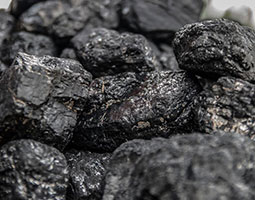Description

Coal is an organic sedimentary rock that forms from the accumulation and preservation of plant materials, usually in a swamp environment. To form the thick layer of plant debris required to produce a coal seam, the rate of plant debris accumulation must be greater than the rate of decay. Once a thick layer of plant debris is formed, it must be buried by sediments such as mud or sand. These are typically washed into the swamp by a flooding river. The weight of these materials compact the plant debris and aids in its transformation into coal.
Uses
Coal is a combustible rock and, along with oil and natural gas, it is one of the three most important fossil fuels. Coal has a wide range of uses; the most important use is for the generation of electricity. Coal is also used in manufacturing. If coal is heated the gases, tars, and residues produced can be used in a number of manufacturing processes. Plastics, roofing, linoleum, synthetic rubber, insecticides, paint products, medicines, solvents, and synthetic fibres all include some coal-derived compounds. Coal can also be converted into liquid and gaseous fuels; however, these uses of coal are mainly experimental and done on a small scale.
Source